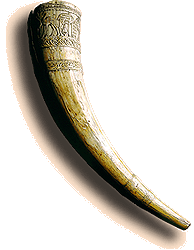 |
Salerno,
Campania (?) Olifant 11th century |
Used as drinking horns or as horns for blowing, olifants were often subsequently transformed into reliquaries and preserved among the treasures of churches.
Here the decoration is mainly concentrated on the borders of the two extremities of the object. The widest is bordered with a band decorated by four pairs of animals facing each other: dromedaries, gazelles, hippogryphs and imaginary quadrupeds sculpted on a plane. Small palm motifs figure between their feet. Pairs of rings decorated with interlacing motifs and foliage run one by the side of this band, and the other near the embouchure. The olifant’s body is smooth.
The animal motifs decorating this piece, which are of Islamic influence, would lead one to think that this is a work executed during the 11th century, in southern Italy, probably in Salerno, in a region where workshops working in ivory and specialising more particularly in the production of olifants, were numerous.Dimensions of the object
L. 55 cm ; D. ouverture 10 cmBibliography
- De l’Egypte ancienne à la Renaissance rouennaise, collections du musée des Antiquités de Rouen, Rouen, 1992, n° 65Location
Musée départemental des Antiquités de Rouen, Seine-Maritime
inv. 1796Photography
Yohann Deslandes, Musée des Antiquités de Rouen